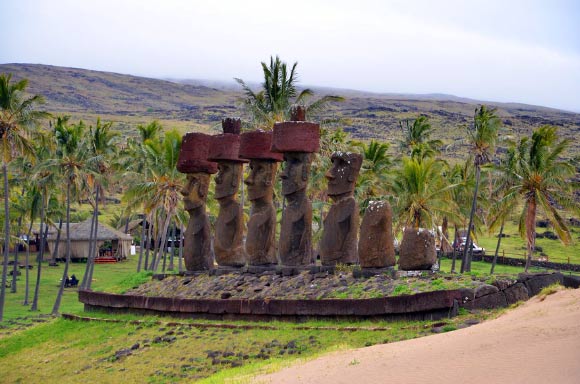Easter Island, also known as Rapa Nui, is famous for its numerous statues (moai) and the monumental platforms that supported them (ahu). A widely-held narrative posits that construction of these monuments ceased sometime around 1600 CE, following a major societal collapse. This narrative remains especially popular in fields outside archaeology that treat collapse as historical fact and use Easter Island as a model for collapse more generally. In a new study, researchers demonstrated that ahu construction began soon after colonization and increased rapidly, sometime between the early-14th and mid-15th centuries CE, with a steady rate of construction events that continued beyond European contact in 1722.

Ahu Nau Nau, a cultural and religious site built by Rapa Nui society on Easter Island’s Anakena beach, was among 11 sites where previously gathered data were examined as part of the new study. The site is located on the north shore of the Easter Island. Image credit: Robert DiNapoli.
“Our research flies in the face of this narrative,” said Dr. Carl Lipo, an anthropologist at Binghamton University.
“We know, of course, that if we are right, we really need to challenge ourselves (and the archaeological record) to validate our arguments. In this case, we thought to look carefully at the tempo of construction events associated with large platforms.”
“The general thinking has been that the society that Europeans saw when they first showed up was one that had collapsed,” said Robert J. DiNapoli, a doctoral candidate at the University of Oregon.
“Our conclusion is that monument-building and investment were still important parts of their lives when these visitors arrived.”
In the new study, the researchers examined radiocarbon dates, relative architectural stratigraphy and ethnohistoric accounts to quantify the onset, rate and end of monument construction as a means of testing the collapse hypothesis.
“Archaeologists assign ages to the archaeological record by getting what are known as radiocarbon dates,” Dr. Lipo said.
“These dates represent the amount of time since some organisms (a bush, tree, etc.) died. Assembling groups of these dates together to look at patterns requires some sophisticated statistical analyses that have only recently been available to archaeologists.”
“We use these tools to provide the first-ever look at the history of platform construction on Easter Island.”
The scientists found that construction of these statues began soon after colonization and increased rapidly, sometime between the early-14th and mid-15th centuries, with a steady rate of construction events that continued beyond European contact in 1722.
“What we found is that once people started to build monuments shortly after arrival to the island, they continued this construction well into the period after Europeans arrived,” Dr. Lipo said.
“This would not have been the case had there been some pre-contact collapse — indeed, we should have seen all construction stop well before 1722. The lack of such a pattern supports our claims and directly falsifies those who continue to support the collapse account.”
“Once Europeans arrive on the island, there are many documented tragic events due to disease, murder, slave raiding and other conflicts.”
“These events are entirely extrinsic to the islanders and have, undoubtedly, devastating effects. Yet, the Rapa Nui people — following practices that provided them great stability and success over hundreds of years — continued their traditions in the face of tremendous odds.”
“The degree to which their cultural heritage was passed on — and is still present today through language, arts and cultural practices — is quite notable and impressive.”
“I think this degree of resilience has been overlooked due to the collapse narrative, and deserves recognition.”
A paper on the findings was published in the Journal of Archaeological Science.
_____
Robert J. DiNapoli et al. A model-based approach to the tempo of “collapse”: The case of Rapa Nui (Easter Island). Journal of Archaeological Science, published online February 6, 2020; doi: 10.1016/j.jas.2020.105094







